Advances and challenges in the field of plasma polymer nanoparticles
- PMID: 29046847
- PMCID: PMC5629419
- DOI: 10.3762/bjnano.8.200
Advances and challenges in the field of plasma polymer nanoparticles
Abstract
This contribution reviews plasma polymer nanoparticles produced by gas aggregation cluster sources either via plasma polymerization of volatile monomers or via radio frequency (RF) magnetron sputtering of conventional polymers. The formation of hydrocarbon, fluorocarbon, silicon- and nitrogen-containing plasma polymer nanoparticles as well as core@shell nanoparticles based on plasma polymers is discussed with a focus on the development of novel nanostructured surfaces.
Keywords: gas aggregation cluster source; nanocomposite; nanoparticles; plasma polymer; sputtering.
Figures


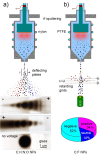
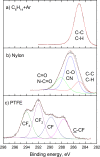
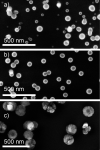
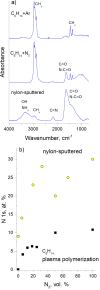
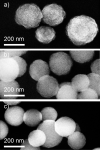


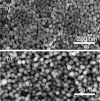
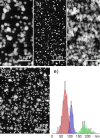
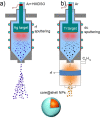
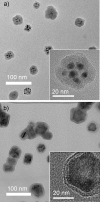
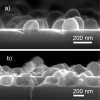

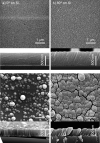
Similar articles
-
Magnetron Sputtering of Polymeric Targets: From Thin Films to Heterogeneous Metal/Plasma Polymer Nanoparticles.Materials (Basel). 2019 Jul 25;12(15):2366. doi: 10.3390/ma12152366. Materials (Basel). 2019. PMID: 31349580 Free PMC article.
-
Nanostructured Plasma Polymerized Fluorocarbon Films for Drop Coating Deposition Raman Spectroscopy (DCDRS) of Liposomes.Polymers (Basel). 2021 Nov 21;13(22):4023. doi: 10.3390/polym13224023. Polymers (Basel). 2021. PMID: 34833322 Free PMC article.
-
Core-shell molecularly imprinted polymer nanoparticles with assistant recognition polymer chains for effective recognition and enrichment of natural low-abundance protein.Acta Biomater. 2014 Feb;10(2):769-75. doi: 10.1016/j.actbio.2013.10.007. Epub 2013 Oct 17. Acta Biomater. 2014. PMID: 24140608
-
Synthesis of silica-polymer core-shell nanoparticles by reversible addition-fragmentation chain transfer polymerization.Chem Commun (Camb). 2013 Oct 14;49(80):9077-88. doi: 10.1039/c3cc45319g. Epub 2013 Sep 2. Chem Commun (Camb). 2013. PMID: 23999877 Review.
-
Antimicrobial Nanostructured Coatings: A Gas Phase Deposition and Magnetron Sputtering Perspective.Materials (Basel). 2020 Feb 8;13(3):784. doi: 10.3390/ma13030784. Materials (Basel). 2020. PMID: 32046363 Free PMC article. Review.
Cited by
-
Novel Dextran Coated Cerium Doped Hydroxyapatite Thin Films.Polymers (Basel). 2022 Apr 29;14(9):1826. doi: 10.3390/polym14091826. Polymers (Basel). 2022. PMID: 35566996 Free PMC article.
-
Mechanical time-of-flight filter based on slotted disks and helical rotor for measurement of velocities of nanoparticles.Sci Rep. 2021 Mar 19;11(1):6415. doi: 10.1038/s41598-021-85533-7. Sci Rep. 2021. PMID: 33742023 Free PMC article.
-
Magnetron Sputtering of Polymeric Targets: From Thin Films to Heterogeneous Metal/Plasma Polymer Nanoparticles.Materials (Basel). 2019 Jul 25;12(15):2366. doi: 10.3390/ma12152366. Materials (Basel). 2019. PMID: 31349580 Free PMC article.
-
Chitosan-Hydroxyapatite Composite Layers Generated in Radio Frequency Magnetron Sputtering Discharge: From Plasma to Structural and Morphological Analysis of Layers.Polymers (Basel). 2020 Dec 21;12(12):3065. doi: 10.3390/polym12123065. Polymers (Basel). 2020. PMID: 33371342 Free PMC article.
-
Materials nanoarchitectonics at two-dimensional liquid interfaces.Beilstein J Nanotechnol. 2019 Jul 30;10:1559-1587. doi: 10.3762/bjnano.10.153. eCollection 2019. Beilstein J Nanotechnol. 2019. PMID: 31467820 Free PMC article. Review.
References
-
- Jenkins A D, Kratochvíl P, Stepto R F T, Suter U W. Pure Appl Chem. 1996;68:2287–2311. doi: 10.1351/pac199668122287. - DOI
-
- Yasuda V H, editor. Plasma Polymerization. New York, NY, U.S.A.: Academic Press; 1985.
-
- Biedermann H, Osada Y. Plasma Polymerization Processes (Plasma Technology) Amsterdam, Netherlands: Elsevier; 1992.
-
- Biedermann H, editor. Plasma polymer films. London, United Kingdom: Imperial College Press; 2004. - DOI
-
- Friedrich J. Plasma Processes Polym. 2011;8:783–802. doi: 10.1002/ppap.201100038. - DOI
Publication types
LinkOut - more resources
Full Text Sources
Other Literature Sources
